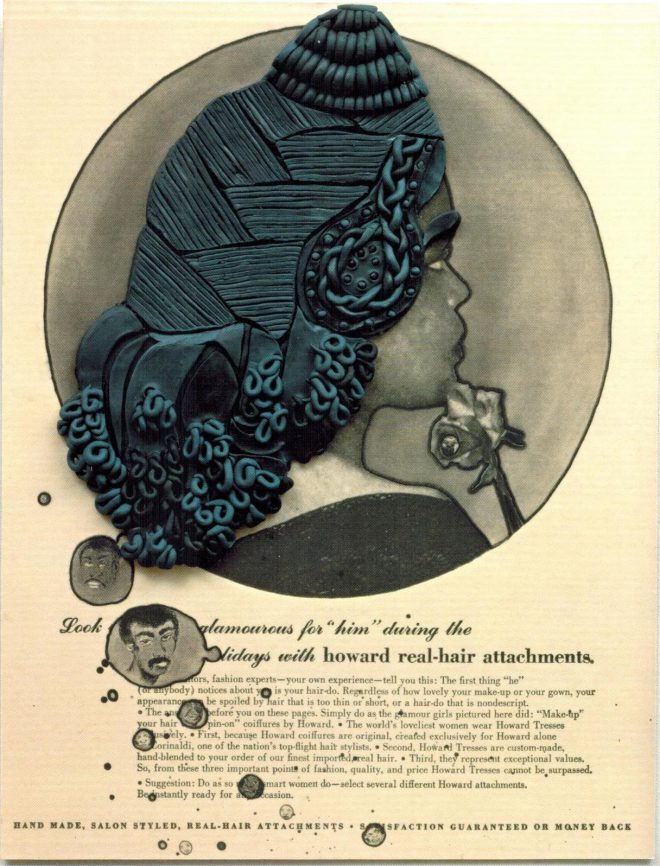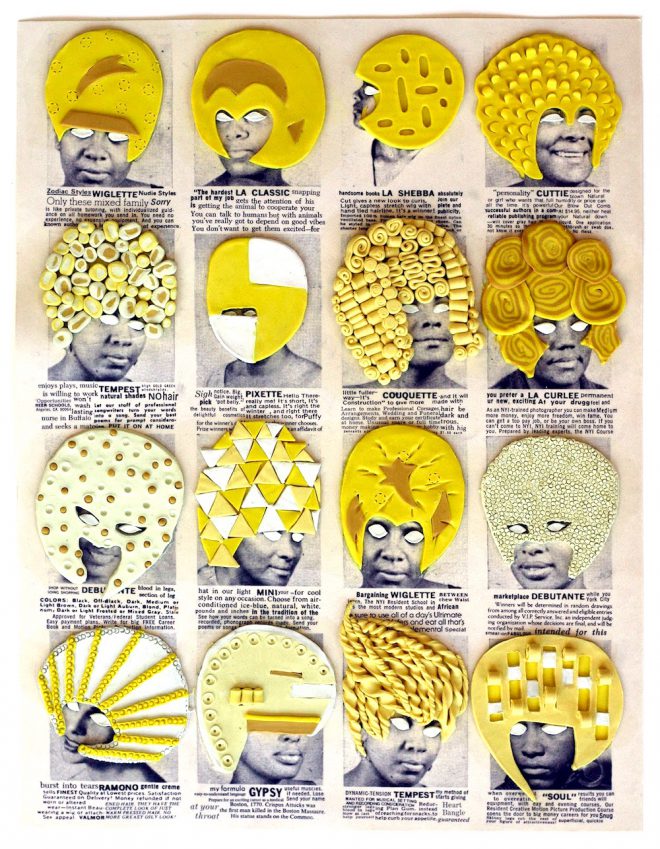For the Cyborg in You: Hair as Medium, Hair as Technology
Atlanta-based writer, Kristin Juarez, revisits an Ellen Gallagher series to discuss the future of hair.

Ellen Gallagher, DeLuxe (Detail), 2004–5. Suite of 60 mixed media works on paper. Courtesy the artist.
Sometimes I want a built-in scalp
that looks and feels like skin. A form of camouflage,
protection against sunburn and frostbite,
horsehair that covers the nightmares and makes me civilized.
–Excerpt from Wigphrastic (After Ellen Gallagher) by Terrance Hayes
In his ekphrastic poetic response to Ellen Gallagher’s DeLuxe, 2004-5, an elaborate 60-piece print project manipulating old advertisements for wigs and black hair products, Terrance Hayes begins in the spirit of Gallagher’s alternating geometric and organic helmets, masks, and googly eyes. Hair’s function as technology, as transformative tool, imaginative spring, and shield. As a site of public memory, hair, wigs, and weaves have always been a locus of attention, careful surveillance, codes that append to the body.
Gallagher transforms the once commonplace advertisements with various techniques of mark making, taking time to imagine each image, each product, each body for its singular potential of pattern, texture, and form. Once equipped for (the fantasy of) the future, the men and women take on alien-like features, superhero garb, and cartoonish styles at once futuristic and ancestral, fanciful and loaded. Between synthetic and organic materials of hair, paper, and ink, in Gallagher’s manipulation, the humor of style, the insidiousness of fitting in, the audacity of standing out are repeatedly linked and unlinked.
From the DeLuxe series, we are reminded that hair is a time-based medium of both epoch and duration. How long would it take to count the strands on a head? How much time will you spend at the hair salon? How much time does it take to grow out a bad hairstyle? According to the ads, the answer to all of those questions is wigs—wigs for nostalgia, wigs for the machine age, wigs for the cosmos, wigs to save time, wigs for your age.

Ellen Gallagher, DeLuxe (Detail), 2004–5. Suite of 60 mixed media works on paper. Courtesy the artist.
We can imagine the ads for our dystopian future using the same opening lines of Hayes’ Wigphrastic selling the hair work/sculpture/design of an artist like Joanne Petit-Frere. Complete with promises to protect you from the harsh elements and omnipresent surveillance, you will be equipped to face the space age with style. The promises (and threats) of CCTV and facial recognition to capture time and identity will be thwarted by an elaborate mask of braids effectively hidden among the endless hours of footage. But this is not a nightmare of the distant future, and we are already adapting.
Every once in a while when I’m walking through Atlanta, I come across a synthetic braid, a ball of hair, a perfectly crimped strand somehow cut loose, lost, or otherwise slipped from its weft and laying on the sidewalk—leaving behind a trace of the past, a trace of machine, a trace of a perhaps already discarded alias. As preconceived as a “built-in scalp,” natural hair, wigs made from horsehair, weaves from Virgin Remy hair all affix to the body, the site where human, animal, and machine meld; where distinctions of science, fiction, and social reality are ambiguous, and black women are thoroughly cyborgian.



